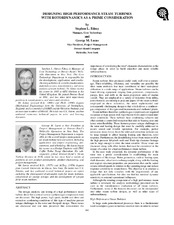| dc.description.abstract | Steam turbines first produced useful work well over a century ago. Their reliability, efficiency, and versatility are possibly the three man attributes that have contributed to their widespread utilization in a wide range of applications. Steam turbines can be found driving equipment ranging from generators, compressors, pumps, fans, and mills to the main propulsion units of marine vessels. They are employed in a variety of industries from utility, petrochemical, and mining to pulp and paper. Of the steam turbines employed in these industries, the most sophisticated and consequently challenging design is that which drives a synthesis-gas compressor of the type used in ammonia and methanol plants. Steam turbines that drive synthesis-gas compressors are required to operate at high speeds with high throttle flows and elevated inlet steam conditions. These turbines have condensing exhausts and often contain a controlled extraction that adds to bearing span and hence rotor flexibility. These features present unique challenges to the rotor and bearing design that must be carefully addressed to assure sound and reliable operation. For example, partial admission steam forces from the inlet and extraction sections can be large enough to affect bearing loading and, therefore, rotor response. Furthermore, the destabilizing forces from steam swirl in the high-pressure labyrinth seals and blade tip clearance leakage can be large enough to drive the rotor unstable. These issues are discussed along with other factors that must be considered in the design of a rotor for a high performance steam turbine. In the case study presented, the dynamic performance of the rotor was a prime consideration in establishing the main parameters of the design. Rotor geometries, such as bearing span, shaft diameter, wheel and overhung weight, along with the bearing and support structure properties, are parameters that can be varied to tune critical speeds in relation to the operating range and reduce response sensitivity to steam forces. The objective is to produce a design that not only complies with the requirements of any applicable specifications, but also one that has minimal dynamic sensitivity to external operational influences. Although the rotating component of a high performance steam turbine is reviewed, the analysis methodology presented can be used in the rotordynamics evaluation of all steam turbines. Furthermore, some of the features discussed can be incorporated into other steam turbine designs, as well as other types of turbomachinery. | en |


